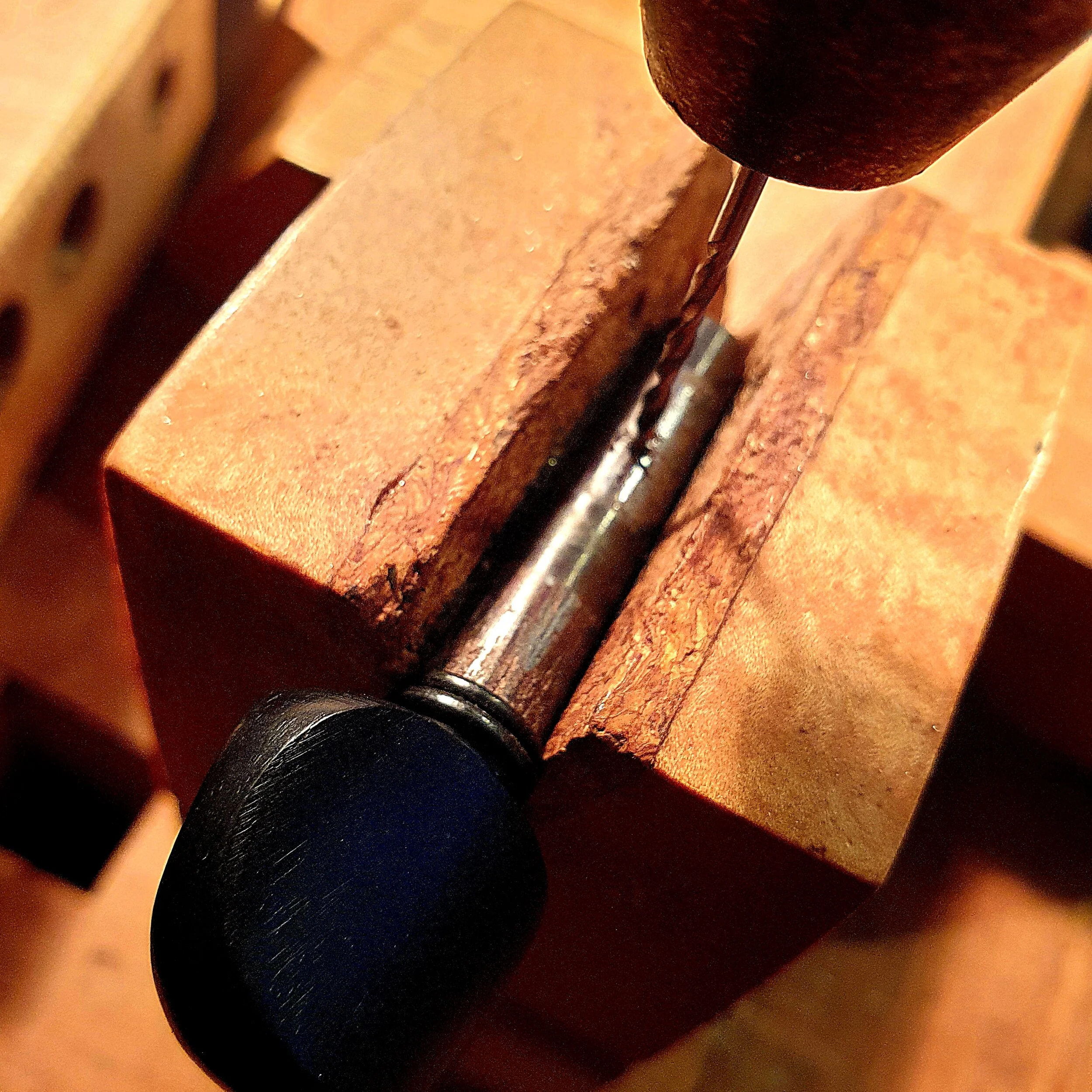About Instrument Care
Already know what you are looking for? Click to go to the service category directly.
Not yet? See below for all the workshop services available to you at Bridge Street Violins
(with a short description and some photos).
The small-print:
Cost Estimates: Prior to starting work, we provide a detailed cost estimate for service-, repair- and/or restoration work based on the best possible appraisal of the issues through careful visual inspection (including - if possible - using an endoscope to check for potential issues from the inside). If, after the cost estimate for the work has been agreed and work on your project has commenced, issues do come to light, that we did not or could not anticipate or find evidence of during the visual inspection, then we reserve the right to revise the previous estimate and discuss the next best steps with you.
Pegs
The pegs move the most on an instrument. Traditionally they are made of ebony - for its hard wearing properties. A lot depends on their taper, their fit to the peg box walls and their string fixture placement, not to mention the strings should not touch other pegs...
A good set of pegs that is well fitted will be a joy for a long time. Once done well, it hardly needs looking after.
It would only need the occasional lubrication, nothing else.
It is a joy to be able to do a set of pegs well for a customer. Plus when they are done right, they are nice to look at too.
Fingerboard
Any material wears out through use. The durable hardwood used for our fingerboards is no exception.
Strings need a ‘flat’ surface to work smoothly. Through wear the string forms ‘tire-tracks’ and the vibrations of the string are hindered. The sound of your violin is getting dampened and dulled.
Re-surfacing a fingerboard is a routine procedure and usually a chance to check other string ‘vitals’ such as the string flow from peg to tailpiece, and string length proportion adjustments.
Topnut
A tiny piece of wood at the top of the fingerboard. It is often forgotten, but vital for a good sounding instrument. For the string flow, the topnut determines the change of direction from horizontal to angled into the pegbox.
Any deviation from a continuous flow brings outside pressure onto the string and it dampens the sound and could also shorten the string’s life.
Soundpost
Often called the soul of the instrument. Notoriously hard to do well as the soundpost is fitted when the instrument is closed. It needs to feed through the soundhole and then maneuvered into the exact right position, stood up exactly straight, with 100% contact fit with the top and bottom plates and at the right tension.
Here is where experience, built up over many years, really shines through. The soundpost focusses the instrument’s sound. An instrument without a post sounds hollow, like the echo-ey delay you get in a big open acoustic building (like for instance inside a Gothic church). It also keeps the sound body together and intact under the duress from the sideways and lengthways push and pull from the strings.
It is an essential part to get right.
Bridge
If the Soundpost is the soul of the instrument, the bridge is the heart. In essence the bridge holds the strings up, feeds the vibrations down indirectly to the sound body to transfer movement into sound.
A fine bridge ensures the strings are at equal distance, it ensures the strings are not too far away from the fingerboard, nor too close. It maintains perfect contact with all of the feet to the top arch. It is thin enough to allow for fast and easy achievable sound, yet strong enough to with stand the force of the strings onto the instrument without bending over. And it is well trimmed to allow for optimal harmonical colouring.
It pays off to trim a bridge well, as it could make the instrument compete for sound quality with another of a higher price class.
Saddle
The saddle in itself might not be as exciting as the two previously mentioned pillars (Soundpost and Bridge), but it pays off not to overlook it. Many shrinkage cracks originate from the sides of the saddle. Leaving a little room at the side ends allows for the softwood of the top plate to move as and when it wants to. This massively lowers the likelihood for a big repair bill later down the line.
The cold winter months are usually the ones where shrinkage cracks appear. Heated houses have low humidity, so the instrument’s wood loses in density and volume.
Clean and Polish
To clean instruments with sensitive varnishes we use a traditional polish - created in-house - which has been used by generations of other violin trade professionals. Furthermore we can use a light abrasive polish to take away the more stubborn grime. Finally we can apply a thin coat of wax - also used in the British Museum - to protect the varnish.
Another thing to check is for instance buildup of rosin in the soundholes as it can build a connection between the inner points and the curve across from it. This dampens the sound massively, could be an origin for an unwanted buzz and it should be opened up if existing.



























